The 2017 hurricane season has proven to be one for the recordbooks, reminding everyone of the importance of being prepared tohandle catastrophic losses. As demonstrated by Irma, the most dangerous aspect of acatastrophic hurricane is the accompanying storm surge along thecoastline.
|Equally important, the sheer wind speeds (and tornadoes spawnedby the remnants of the storm) can wreak havoc hundreds of miles inland. Thesehigh winds can prove particularly damaging to roofs, siding, fencesand HVAC systems.
|And while many adjusters are experienced in assessing andestimating the costs to repair structural damage, diagnosingwind-driven damage to HVAC units can be particularly difficult.
|A visual assessment of the extent of damages to an HVAC systemis the first of many critical steps in reaching an appropriatescope of repairs (and associated settlement) to return the insuredto pre-loss condition.
|Related: Hurricanes and homeowners' insurancedeductibles
|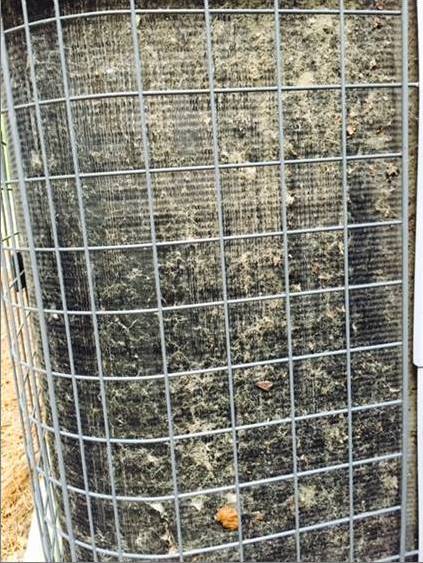 Condenser coilclogged with dirt and debris following high winds of a storm.(Photo: HVACi)
Condenser coilclogged with dirt and debris following high winds of a storm.(Photo: HVACi)
Dust and debris-clogged condenser coils
High winds that accompany a hurricane often lead to excessiveairborne dust and debris that will easily (in the best-casescenario) clog the aluminum fins of an HVAC system’s condensercoil. When the storm passes, property owners will often find thefins of the condenser coil packed with dirt, dust, grass, leavesand other small, lightweight objects from the surroundingenvironment.
|When a condenser coil becomes clogged, the airflow through theunit is likewise restricted. This restriction reduces the potentialheat transfer from the refrigerant to the ambient air, and in turninhibits the HVAC system’s ability to adequately cool theconditioned space. It also causes the unit to work harder thanunder normal conditions, and slightly increases the system’s powerconsumption.
|Fortunately, a clogged condenser coil is relatively easy torepair. Coils can be cleaned using condenser coil cleaner and astandard garden hose (a pressure washer should never be used toclean the condenser coil, as this can flatten the coil’s malleablealuminum fins). If performed correctly, this repair action cansufficiently restore a condensing unit to normal operation.
|Related: HVAC compressor damage: Lightning or wear &tear?
|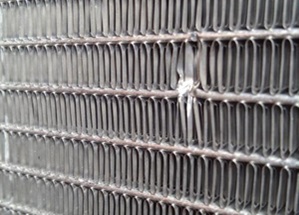 Microchannelcoil damaged by wind-blown debris. (Photo: HVACi)
Microchannelcoil damaged by wind-blown debris. (Photo: HVACi)
Coil fins damaged by windblown debris
The condenser coil’s aluminum fins that surround the copperrefrigerant tubing can be easily bent and flattened. If the strongwinds of a hurricane or other storm send objects flying, they caneasily dent the fins of the coil, similar to the effect ofhailstones.
|Once the fins are flattened, the airflow through the unit isrestricted. As mentioned earlier, this condition can impact thesystem’s cooling capabilities, efficiency, and eventually, if leftunrepaired for an extended period of time, the useful life of thesystem.
|The potential repair actions for condenser coil fins flattenedby wind-blown debris is similar to those used for repairinghail-damaged coils. Combing the coil’s fins should be considered asthe first and most likely remedy. However, if the fins are torn,exceptionally brittle, or if the system utilizes a microchannelcondenser coil (see example photo above), combing may not possible.In this scenario, the next repair action for wind-blown debris isthe replacement of the condenser coil, an often ignored orforgotten repair option.
|If the fins cannot be combed and the coil is no longercommercially available, the condensing unit may need to bereplaced. Finally, if the replacement of the outdoor condensingunit leads to a technical or regulatory mismatch with the remainingequipment, full system replacement may be required.
|Related: Keys to identifying hail damage to HVAC condensercoils
| 
The fins of this condensing unit were protected from thewind-blown debris; however, the corner panel was dented. The systemwas repaired by replacing the individual panel. (Photo:HVACi)
|Large foreign object impact to the condenser coil
Unlike smaller debris that simply clogs or dents the condensercoil, large, heavy objects picked up by strong winds can causesignificant damage to an outdoor condensing unit. Hurricane forcewinds can send objects such as large branches, shallow-rooted treesor heavy building materials flying. If these objects make contactwith the condensing unit, they may penetrate the refrigerant lines,damage multiple system components or even crush the system in itsentirety.
|The extent to which a system is damaged depends not only on theweight and speed of the flying object, but also on the constructionof the condensing unit. Of course, the severity of system damageand availability of replacement parts will dictate if the unit isrepairable.
|Related: Avoid getting blown away by wind damageclaims
|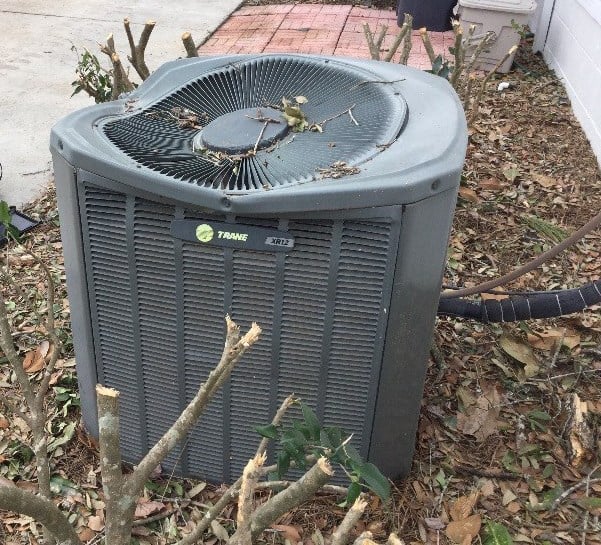 Condensing unit damaged by heavy, wind-blown object.(Photo: HVACi)
Condensing unit damaged by heavy, wind-blown object.(Photo: HVACi)
Displaced Equipment
During a hurricane, 160-mile-per-hour winds can take a toll onHVAC equipment. While the typical residential condensing unitweighs between 150 and 200 pounds, it can still be easily blownaskew from its position on the rooftop or ground pad. Followingtornadoes and hurricanes, it is common to see equipmentdisplacement ranging from minor shifts to those that are completelyblown over.
|Related: Top 10 costliest hurricanes in theU.S.
|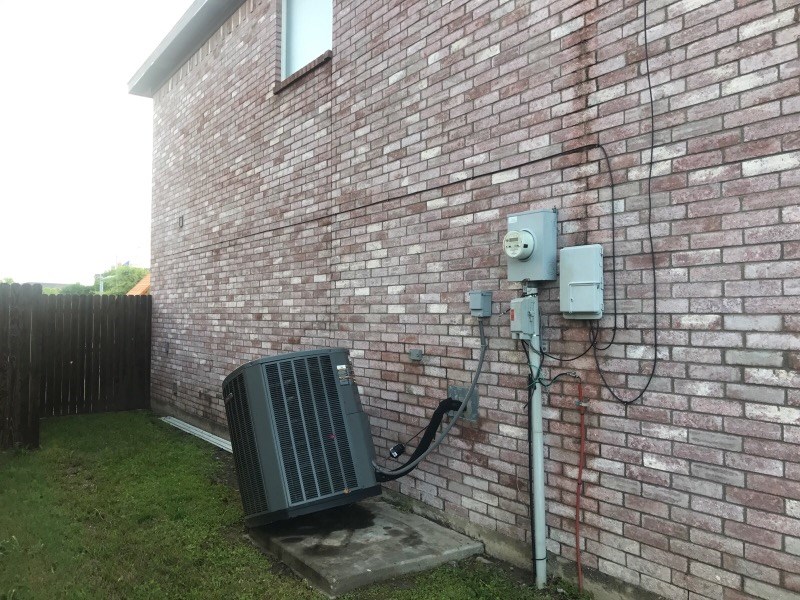 Condensing unit blown off of pad by high winds. (Photo:HVACi)
Condensing unit blown off of pad by high winds. (Photo:HVACi)
Blown away
Once a condensing unit has shifted on the pad, it is importantto assess whether or not the refrigerant lineset has been breached.If so, moisture and contaminants may have entered the refrigerantloop and can cause significant damage to the compressor. If theunit was blown over, the condenser coil and the fan assembly mayalso be damaged. Depending on the extent of the damage, repairs maystill be possible, up to and including the replacement of thecondensing unit.
|Fortunately, in hurricane-prone areas such as Florida, buildingcode regulations often require that all outdoor mechanicalequipment exposed to wind be able to withstand wind pressures, orbe securely fastened to the ground/rooftop (Florida Building Code,Mechanical Sec 301.15).
|The required wind resistance depends on both the specific countyand usually, the zone within that county. As an example, inMiami-Dade County Risk I, mechanical equipment is required to beable to withstand gusts of wind for three seconds at speeds of upto 165 mph (Florida Building Code, Sec 1620.2).
|Related: Business continuity plans & technology helpbusinesses weather Hurricane Harvey
|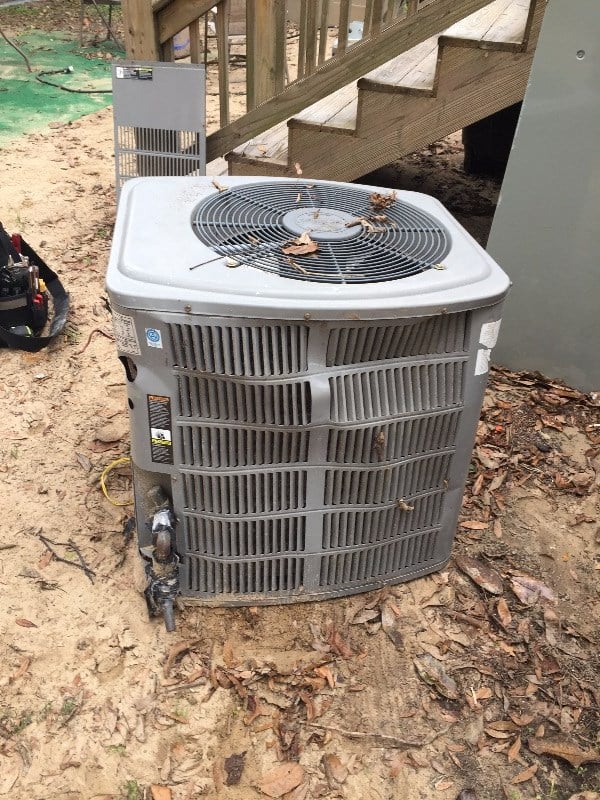 Significant damage toa condensing unit during a hurricane. (Photo: HVACi)
Significant damage toa condensing unit during a hurricane. (Photo: HVACi)
As with any property claim, it is important for adjusters toconsider all options before coming to a settlement decisionfollowing a hurricane or tropical storm, and a thorough visualinspection is the first critical step along the settlementpath.
|Although devastating, wind-damaged HVAC systems are oftenrepairable, if objectively evaluated by a licensed professional.Most HVAC configurations include both outdoor and indoor equipment,offering frequent opportunities to return the system to pre-losscondition via simple and straightforward repairs.
|For information on water and lightning damage accompanyinghurricane claims, you can access our adjuster toolkit for hurricane claims. You canalso review a labeled split system diagram and a labeled packaged unit diagram, to assist in identifyingcomponents and their susceptibility to wind and foreign objectimpact damage.
|Matt Livingston is the director of customer education forHVAC Investigators ([email protected]), aleader in independent assessments of HVAC and refrigeration claimsfor insurance carriers. He is responsible for providingcontinuing education to insurance professionals on various heatingand air conditioning topics and is also responsible for developmentof field diagnosis best practices. He is a frequent author andspeaker on this topic, and holds an EPA 608 UniversalCertification.
Want to continue reading?
Become a Free PropertyCasualty360 Digital Reader
Your access to unlimited PropertyCasualty360 content isn’t changing.
Once you are an ALM digital member, you’ll receive:
- All PropertyCasualty360.com news coverage, best practices, and in-depth analysis.
- Educational webcasts, resources from industry leaders, and informative newsletters.
- Other award-winning websites including BenefitsPRO.com and ThinkAdvisor.com.
Already have an account? Sign In
© 2024 ALM Global, LLC, All Rights Reserved. Request academic re-use from www.copyright.com. All other uses, submit a request to [email protected]. For more information visit Asset & Logo Licensing.








